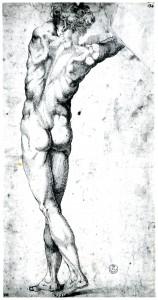Florence, Uffizi, no. 6496F.
Pen and ink, 41 x 21.7; no wm. visible.
LITERATURE:
Ferri, 1890, 125, as Rosso.
Berenson, 1903, 1938, 1961, under no. 992, as a copy of the figure at the right in a drawing in the British Museum (1895-9-15-562) that he gave to Granacci (1938, III, Fig. 395).
Barocchi, 1950, 196, n. 4, as Bandinellian and perhaps by Rosso in his Florentine period.
Carroll, 1964 (1976), I, Bk. I, 171-172, II, Bk. II, 266-270, D. 24A (COPY), Bk. III, Fig. 79, as a copy of a lost drawing by Rosso of around 1527-1528 (with another copy in the Louvre, Inv. 858 [RD.29]); “Addition to the Preface,” 1976, vii, as questionable that it reflects a lost drawing by Rosso.
This drawing is closely related to one in the Louvre, Inv. 858 (Fig.RD.29). In 1964 I thought that they were both copies of a lost drawing by Rosso of around 1527-1528 that would have been similar to his study in the Albertina (Fig.D.26A) for the figure of Christ in the Pietà in Borgo Sansepolcro. I questioned this connection in 1976 and now no longer recognize the drawing as related to Rosso. The figure in the Albertina is much more carefully observed from its model, its shading much more subtle and less systematized, and its contours more taut. Neither the Uffizi nor the Louvre drawings show these characteristics and even if assumed to be copies of a single lost drawing they do not now seem to me to show a reflection of the subtle and personal characteristics of the Albertina drawing to warrant an assumption that they are derived from a drawing by Rosso. Their similarities are simply Michelangelesque.1 (It also appears at this time that the clear separation of the muscles and of the locks of hair in the Uffizi drawing indicate a derivation from the Louvre drawing or from an original of which the Louvre drawing would be a closer copy than the Uffizi drawing.)
Berenson thought that the figure copies the nude at the right in a drawing in the British Museum (1895-9-15-562) that he thought was by Granacci but that is now generally acknowledged as Bandinelli’s (Fig.Bandinelli, Nudes).2 Berenson’s observation is not strictly true, as the hair is different as well as the position of the arms. The figure in the Uffizi and Louvre drawings also has more elongated proportions. The ultimate source of this type of male nude seen from the back is probably a figure on an antique sarcophagus.3 But it may be more specifically dependent on a drawing by Michelangelo, one possibly related to Sebastiano del Piombino’s Flagellation in S. Pietro in Montorio.4
1 In Carroll, 1964 (1976), I, Bk. I, 273, n. 58, I commented that the Uffizi and Louvre drawings suggest that their author knew early pen drawings by Michelangelo of the type represented by his study of a male nude seen from the back in the Casa Buonarroti (73F; Barocchi, 1962, Text, 12-13, Plates, Pl. XVIII).

